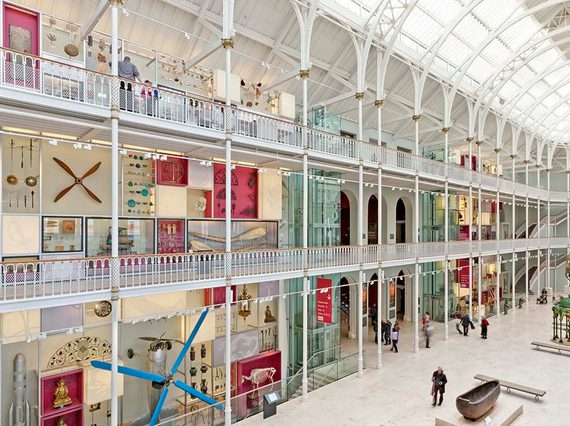
Exchange: Community-Led Collections Research
National Museums Scotland has been awarded a grant by the Arts and Humanities Research Council (AHRC) with the National Maritime Museum, London, to enable organisations around the UK to work with community groups to explore experiences of empire, migration, and life in Britain through their collections.
Last updated: 7 March 2024
About the project
The £450,000, 18-month pilot project, entitled Exchange: Community-Led Collections Research, sees funding distributed to galleries, libraries, archives and museums to work with South Asian, African and Caribbean diaspora organisations to answer research questions identified by these community groups.
National Museums Scotland and the National Maritime Museum, London are working as a hub; gathering evidence for best practice guidelines, providing expert guidance and holding a central fund which is distributed to partner organisations around the UK.
Outputs will include new research into the historic and contemporary meanings of objects, which will inspire new, creative projects defined by community groups and centered around partner organisations’ collections. These will challenge and expand on established representations of diaspora experiences.
Downloads List
- Project title
Exchange: Community-Led Collections Research
- Project active
2021 - 2022
- Research theme
Scotland's Material Heritage
Project team
National Museums Scotland
Dr John Giblin - Principal Investigator, Keeper for Global Arts, Cultures and Design
Dr Yahya Barry - Community Collections Research Hub Manager at National Museums Scotland and a senior visiting researcher at the University of Copenhagen’s Centre of African Studies
Iona Diver - Hub Administrator and Departmental Administrator for Global Arts, Cultures and Design
Jilly Burns - Head of National & International Partnerships
Janie Hopkins - Head of Learning & Engagement
National Maritime Museum, London
Dr Robert Blyth - Co-investigator, Senior Curator of World History at National Maritime Museum
Sally Archer - Research and Heritage Partnerships Manager
Sarah Lockwood - Head of Learning and Interpretation
Dr Aaron Jaffer - Curator, World Cultures
Roz Croker - Senior Manager: Partnerships and Public Engagement
Charlotte Paddock - Adults and Communities Participation Manager
Project collaborators
Confirmed partner organisations in Scotland include:
Museums & Galleries Edinburgh
Glasgow Life
David Livingstone Birthplace
Confirmed partner organisations in England include:
Museum of the Home
National Museum of the Royal Navy
Brunel’s SS Great Britain
Tyne & Wear Archives and Museums
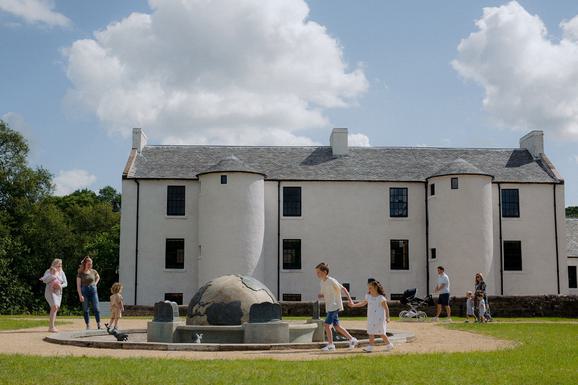
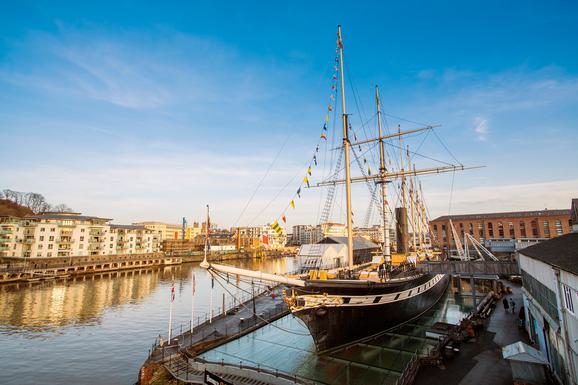
We want to support greater equality, diversity and inclusion within the galleries, libraries, archives and museums sector in the UK. To do this we need to consider who is visiting our institutions and what they find there when they do. We need to invest more work in how histories of empire, migration and life in Britain are told from the perspective of diaspora communities. This generous grant from the AHRC will allow organisations to work with UK communities who have historically been marginalised in museum and gallery displays to reveal and share a wider range of stories and perspectives.
Dr John Giblin, Keeper of Global Arts, Cultures and Design at National Museums Scotland
Project updates
David Livingstone Birthplace
Community partners
David Livingstone Birthplace (DLB) created their own community group by recruiting six participants from the African, South Asian and Caribbean diaspora communities. The call for participants was shared through the West of Scotland Regional Equality Council, Jambo! Radio and DLB partner’s networks.
Project overview
The Exchange group had a strong interest in forgotten stories, challenging traditional narratives and examining the legacies of these narratives in a contemporary context, and the perception of African culture today. They were especially interested in how the DLB collection spoke to the African cultures, communities and individuals Livingstone encountered and revealing their stories through object research and creative practice.
Research themes
Two objects became focal points for research: a fibrous grain urn belonging to either Abdullah Susi or James Chuma, two African men who worked on Livingstone’s expeditions, and an Mbila (xylophone) made by the Chopi people.
From these interests, the participants posed two research questions:
What can everyday objects such as a grain urn reveal about the experience of the African community groups and individuals that supported Livingstone?
How can the contemporary significance of objects such as musical instruments be activated by creative responses that draw from lived experience?
Tingatinga Party
DLBM Exchange Group organised and hosted a free Tingatinga style drop-in event that featured live music from ‘The Gig Group’, food and storytelling with performances from artist Gameli Tordzro, a Tingatina inspired art installation by artist Josie Ko, a specially commissioned film by Mara Menzies and the launch of a new zine exploring untold stories in response to David Livingstone Birthplace Museum (DLBM) collections.
Edinburgh Museums & Galleries
Community partners
Edinburgh Caribbean Association
Project overview
Looking at the collections in the Museum of Childhood, the group focused on comparing experiences of childhood in Scotland and the Caribbean exploring lack of representation, policisation of childhood and possible racism in the collections.
"I don't see my childhood here"
Discussing their own experiences of childhood led the group to explore traditional sayings and their meanings, music, food, and folklore. The project provided a unique opportunity for intergenerational working and collaboration with individuals and communities in the Caribbean.
Creative outcomes
The group have developed Respect! Caribbean Life in Edinburgh, an exhibition that will showcase the research and work produced throughout the project.
Through working with a therapist and heritage consultant from the Caribbean community the group have explored difficult and upsetting topics with emotional support in a safe space and have processed their emotional responses through creative writing, poetry, art and music.
After feedback form the group the ‘Other Worlds’ display will be removed and the general displays in the doll’s gallery will be changed to be more representative of the diversity of Edinburgh and engage with a wider range of communities.
Glasgow Life
Community partners
BAG (Bangladesh Association Glasgow) and young people from the OSCH (Our Shared Cultural Heritage) programme.
Project overview
The project researched and interpreted The plaque is a rare piece of evidence for the existence of Bengali speaking sailors (Lascars) in Glasgow in the 1800s.
The groups’ research was centered on questions relating to a plaque inscribed with 'Lascars Only' in English and Bengali originally used above the entrance to the toilet facilities for the seamen at Queen’s Dock in Glasgow Museums collection including:
Did the wording suggest segregation or additional provision?
Was it well received or reluctantly used?
Did it last for a long time, or was it an unsuccessful experiment?
Was the name Lascar accepted or merely endured by the men it was used to refer to?
Does the Bengali script accurately describe the facilities provided?
Creative outcomes and engagement
As the groups’ research continued, they found their questions evolved to concentrate less on the actual plaque and more on the experiences of the seamen themselves through art and drama, as well as a deeper investigation of the politics, working lives and the commercial structure of the companies that employed South Asian mariners.
The Bangladeshi Association Glasgow researched, wrote, directed and performed a play titled ‘Lascari’ on The Tall Ship. Originally intended to form part of the Bhasha Language Festival in Glasgow, the performance focused on the lives and experiences of Lascar mariners and included two pop-up displays of the plaque and a selection of rarely seen items from Glasgow Museums’ collections.
The group also arranged and presented at two community seminar events, including ‘Scotland’s Lascar Heritage’ exploring the lives of 'lascars' - South Asian seamen - and their longstanding connections to Scotland.
OSCH produced creative outputs in response to their research into Lascar heritage in Glasgow, including a spoken-word poetry film, a series of illustrations that were printed and made into a range of stationery, a zine and display and engagement at Glasgow Mela. The group documented their progress throughout the project in a series of blog posts.
Museum of the Home
Community partners
Bangladeshi Youth led by artist Rahemur Rahman, and Kasi Ruksana Begum from London Borough of Tower Hamlets.
Project overview
The project merges research interests in British Bangladeshi oral history with a focus on the Bangladeshi bedroom as a space that is often overlooked but full of stories of identity and heritage, especially for women. The project focused on creating a collection of oral history testimonies, photographs, and films that document people’s homes and how they feel about them. Through their experience interviewing and recording stories of identity, the group developed several research questions:
What is the significance of home, homemaking, and belonging to the Bangladeshi diaspora living in London in 2022?
What does home mean for diaspora communities living in London?
How does our heritage and identity affect our creative practice?
How can we use co-production to question assumptions about home and identity?
How can we make curatorial approaches to displaying home more inclusive and participatory?
Creative outcomes
The project worked with a renowned local artist, Rahemur Rahman, to deliver a series of workshops with young people of Bangladeshi heritage to collect their and their families' stories of home. The participants drew upon the content of the interviews to create textiles and objects to form part of a new pop-up bedroom display, My Home, My Bari at the museum. The artwork will allow visitors to step back in time with a multi-sensory art installation using smells, sights, and textures to bring history to life through a representation of the bedrooms of the British-Bangladeshi community around East London, and allowed their stories to be recognised, honoured, and heard.
National Museum of the Royal Navy (NMRN)
Community partners
Chat Over Chai, an inclusive group which celebrates the South Asian community in Portsmouth, and The Royal Navy's Equality & Diversity Team which links Royal Navy personnel from a range of backgrounds, including people from African, Caribbean and South Asian communities.
Project overview
The project ‘Tidal Teatime’ used the associations of drinking tea as a backdrop for difficult conversations about Empire and provide a way of soothing feelings while bringing people together. The group used this as a platform to draw out different perspectives and explore new narratives linked to the NMRN collections.
The group’s research focused on both adding information to the collections and exploring their own thoughts and feelings in response to exploring themes of empire and migration.
Creative outcomes
The community participants chose three items to explore and answer their research questions:
A poster made as propaganda during the Second World War, showing women picking tea in India.
A painting titled ‘Appreciating the Situation’.
The historic ship – HMS Trincomalee.
Through their research and collaboration, the group addressed the history of these objects, redesigned and reinterpreted them, and uncovered some of the forgotten stories associated with them. Three short films were produced to showcase their findings and their responses to them:
Tyne & Wear Archives & Museums
Community partners
Tyneside Research Collective: a group of self-selecting people from the African and Caribbean community. Members are representatives of: North East of England African Community Association (NEEACA), The Angelou Centre, Teakisi, Newcastle University Staff Black, Asian and Minority Ethnic network and Newcastle upon Tyne Hospitals NHS Foundation Trust Black, Asian and Minority Ethnic staff network.
Project overview
The project aimed to explore how the histories of diaspora communities are interlinked, in order to enhance a sense of belonging and to promote a greater understanding of the pluralism of Tyneside. The group developed research questions they hoped to answer throughout the project:
What are the connections between the North East and Indian Indentureship? What are the human stories and non-industry led stories of Indian Indentureship?
Who are the contemporary inspirational women in African, Caribbean and South Asian communities on Tyneside that should be recognised and celebrated?
Creative outcomes
New stories: The Indian indentureship research project culminated in a public event incorporating family histories and half block ship models in the collection that were built in the region and were used to carry people from India to the Caribbean. An interfaith spiritual event was also arranged to honor participant's ancestors.
New additions: The notable women research project involved a contemporary collecting programme to engage women to share their stories to be developed into a trail through the museum. We Are Here: Inspirational Women trail will be a permanent feature in the galleries. The women’s stories will also be accessioned into the museum collections database.
Momentum for future projects on decolonisation: The community steering group invited the TWAM leadership team to meet with them and discuss the project, their responses and their hopes for building on this relationship in the future. The collaborative nature of the project has encouraged open and honest dialogue around themes or representation, barriers to participation, decolonisation, and power, as well as challenging operational practice.Through the research and discussions conducted by the group throughout the project, three strands of creative outputs were developed.
"It's been wonderful to be part of and we all think it's been one of the most important projects we have undertaken in years." - Kylea Little, Keeper of History, Discovery Museum.
SS Great Britain
Community partners
The Bridging Gaps community group based at Hannah More School, where 95% of pupils and parents are of black or minority ethnic origin and is based in a ward with the highest proportion of Black, Asian and Minority Ethnic people in Bristol.
Project overview
The project explored critical questions that relate to the SS Great Britain and its connection to Bristol today:
How do the migration stories of the SS Great Britain's past compare and contrast with community group members' experience of migration and mobility in the modern world?
The community researchers identified a misunderstanding about the historical role of SS Great Britain and its links to slavery, which they also wanted to address through their research. Their research questions focused on passenger stories, their life on board and connections to writing, art and music.
Creative outcomes
A leaflet researched and written by Soumia Seradj titled: ‘Do You Actually Know SS Great Britain’ which she produced to introduce community members to the ship ‘and tell its story in a simple and easy way’. Soumia intends to distribute the leaflet to both the school group and the broader community, and it will be available online.
Shani Whyte was inspired by her research to write a book titled ‘Tying the Tides: The Colour within the SS Great Britain’ which tells the story not only of passengers and crew but also its impact on communities where the ship called such as Africa and Australia. Once printed, copies will be available in UK national libraries, as well as online.
Iwona Salamon researched and produced a ‘Discovery Box’ that focuses on food and life on board the ship with representations of rations that can be handled along with craft activities centred around typical children's pastimes of the period. The boxes will allow school children to explore migration in the past, and how it relates to the contemporary world.
‘Discovering SS Great Britain: Bristol Stories, Personal Journeys’ outdoor exhibition in Brunel Square.
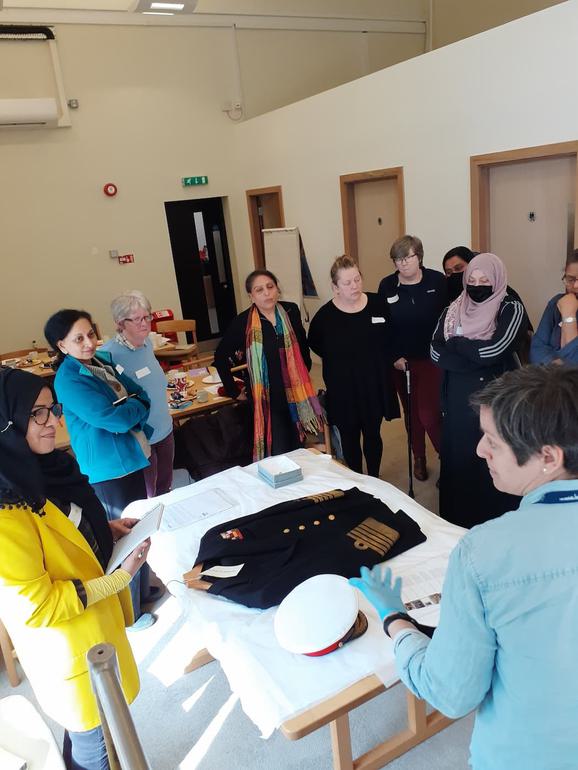
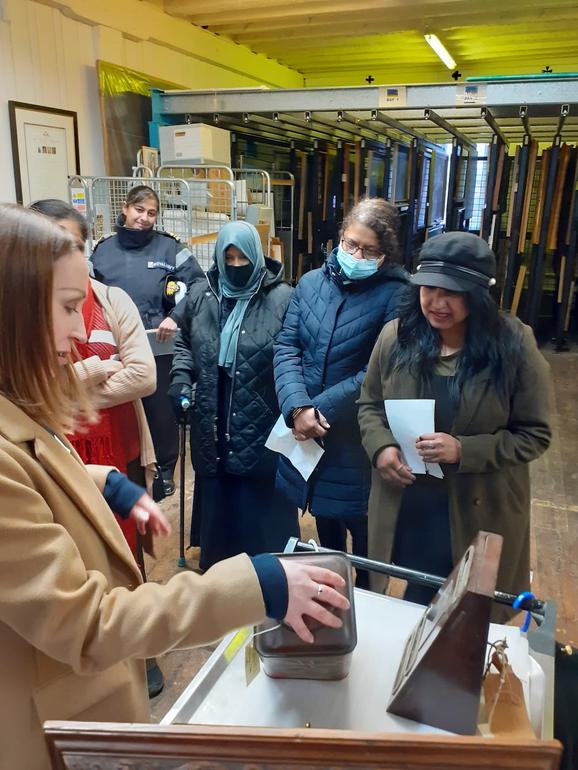
Project contact
Dr John Giblin
